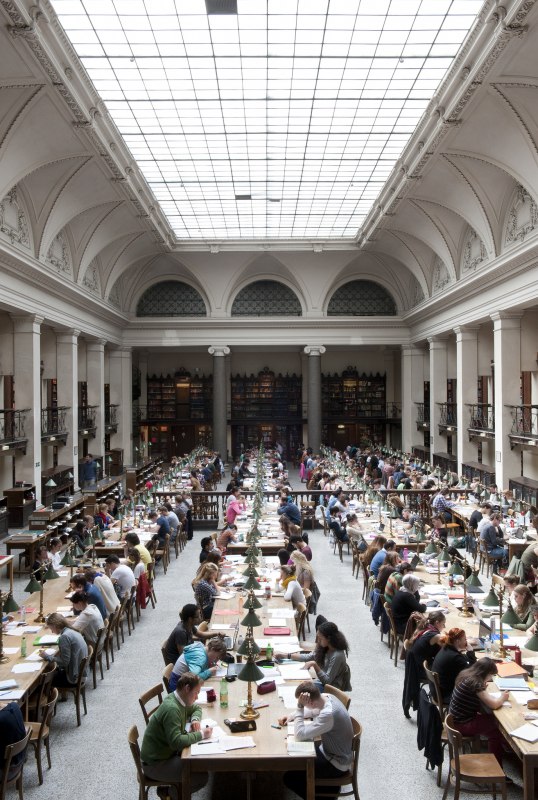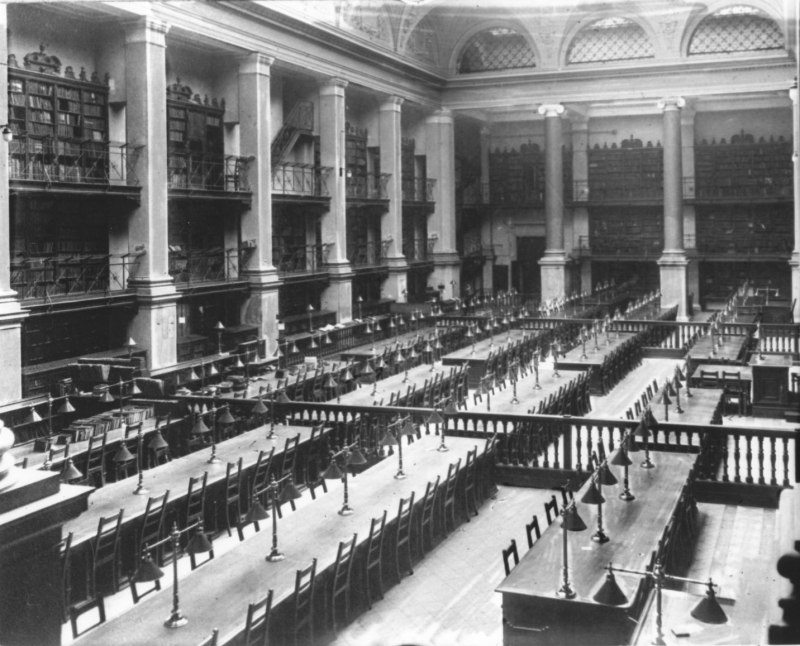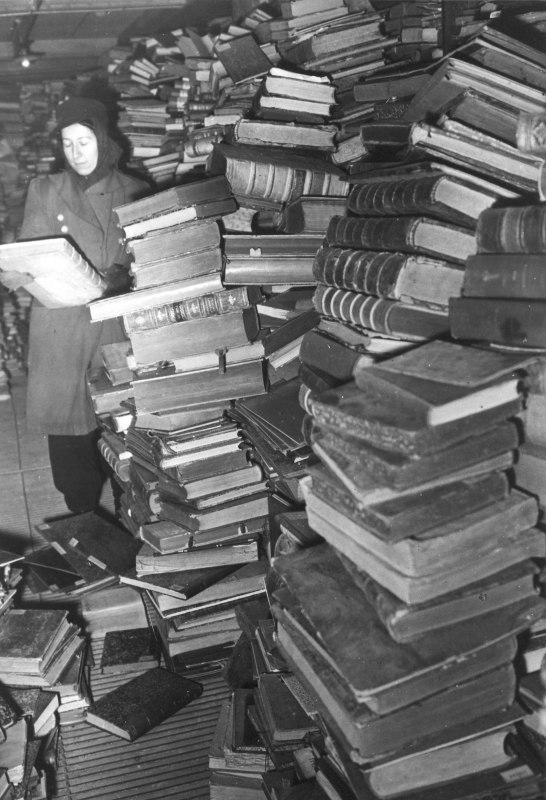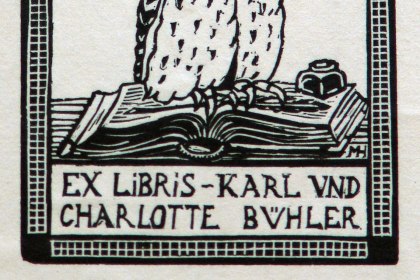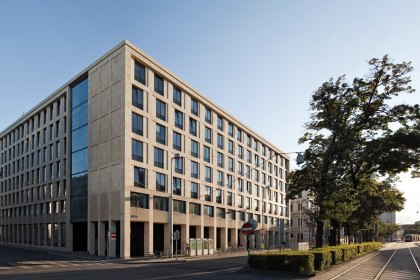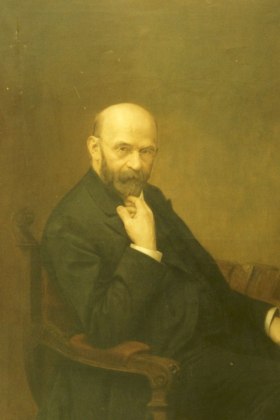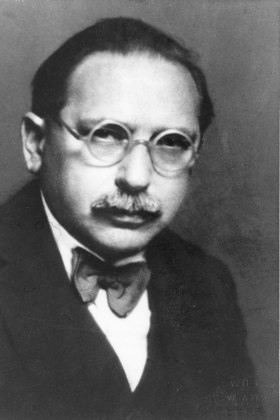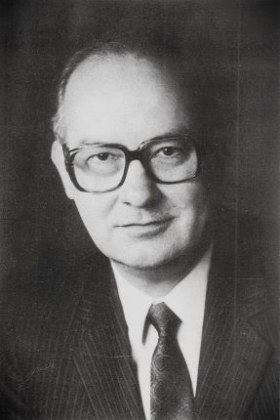Upheavals at the library shelves
The Vienna University Library’s relationship to the University of Vienna and to the state were marked by highs as well as lows in the last 120 years and reflect the upheavals in Austria in this time period.
Relocation to the new University Main Building on the Ringstraße
1884: Today’s Main Library – at the time the University Library – was relocated to the new building on the Ringstraße. The existing lack of space remained a problem: there were no plans to expand the library. During Friedrich Grassauer’s (1840-1903) time as library director from 1884 to 1903, the university library acquired a leading position among the scientific libraries of the Habsburg Empire thanks to modernizations such as the introduction of a reference system or organizing the books by numerus currens. Until the end of the First World War, the University Library of Vienna de facto became the Austrian royal and central library and was one of the leading libraries in Europe in regard to its reader frequency. The number of users rose from just under 85,000 in 1885 to more than 293,000 in 1912. This number was only surpassed in 1966.
1914-1918: During the First World War the conscription led to a lack of personnel and gaps in the inventory, especially concerning foreign journals.
The University Library after the First World War
1920: After the end of the monarchy the former Royal Library and now National Library took over the University Library’s position as state library and thoughts were voiced about consolidating the two. By decree of the office of education, however, both libraries’ independence was confirmed on January 3, 1920.
In 1923 the first female academic, Karola Bielohlawek (1877-1959) was instituted as a specialist. In that year the number of books passed the one million mark for the first time and from then on the Faculty of Philosophy also demanded a copy of each dissertation (legal deposit). Furthermore, a reminder- and overdue books system was introduced, which supposedly “positively affected” the users’ discipline.
1932: Beginning in this year, the Vienna University Library joined the “general catalogue of the Prussian libraries” and subsequently started a new catalogue with new rules for cataloging following the international format.
The University Library during Austrofascism and the Nazi era
1934-1938: In the austrofascist corporate state the Vienna University Library adapted to the political situation. Some “illegal” National Socialists among the librarians were dismissed during this time. Besides Paul Heigl (1887-1945), who worked at the Institute for Austrian Historical Research and later became director of the National Library, three further librarians who had shown themselves to be National Socialists were fired (Robert Hohlbaum, Rudolf Pettarin and Karl Wache).
1938: After the “Anschluss” to the German Reich, the University Library was also internally “brought into line”. Johann Gans (1886-1956), the director at the time, was deposed and the former head of the cataloging department, Alois Jesinger (1886-1964), who had joined the NSDAP in May 1938, was made temporary director. Austria’s political “Anschluss” to the German Reich brought about a radical reduction of the library’s users by half and the dismissal of about 20% of its personnel. Soon the instruction was: “Jews are prohibited from using the university library”. Like other libraries, the University Library also profited from the illegal dispossession of seized property under the National Socialist regime, especially from the Jewish population, but also from politically persecuted people and institutions.
1943/1944: In 1943 and 1944, by decree of the Reich Ministry of Education in Berlin, the University Library had to move almost its entire printed works (more than 1,200,000 volumes) to castles around Vienna and to the National Library with utmost secrecy. About 10% of the books were damaged or lost through the transport, poor storage or other complications resulting from the war.
In early 1945 work at the library practically came to a halt. The few remaining librarians were mainly delegated to the civil air defense. With the end of the war, the former director Johann Gans was reinstated and Alois Jesinger was dismissed without notice. The University Library’s first years after the Second World War were mainly dedicated to reconstruction.
The University Library during the era of reconstruction
It took until 1951 before the reading room could be reopened. Until then the library tried to repair damage to the building and to return the evacuated books to Vienna. The subject of books stolen under the National Socialist regime, which also occurred in the Vienna University Library, was mostly ignored during this time. Only few former owners received their stolen property back from the library in the first few years after the war and the process of coming to terms with the National Socialist era stood still for decades.
1955: In this year attempts at addressing the library’s problem of space with plans for a new building failed repeatedly. Instead, a new institute building was constructed at the proposed site at Liebiggasse 6 (today the New Institute Building, NIG, Universitätsstraße 7).
Also in 1955 the university library was brought closer to the institute and seminar libraries for the first time with the Hochschulorganisationsgesetz (university organization law). On the one hand, institute personnel could complete a library training course at the University Library and on the other a collaboration concerning the catalogue was begun.
1963/1964: In these years the reading area of the Main Library was renovated. It assumed the form it is in today.
Electronic data processing finds its way into the library
1975: Minister of Science Hertha Firnberg (1909-1994) initiated the most politically controversial reform of the post-war years with the Universitätsorganisationsgesetz (university organization law, UOG) of 1975. New regulations for the library transferred the administration of all institute libraries to the University Library and gave the library director a membership and a vote in the academic senate as well as the library commission. Subsequently, the internal structure was adapted to the needs of the time. For example, a department for planning of data processing was established and the Informationsvermittlungsstelle für maschinelle Literatursuche (information agency for automated literature searches, IVS; today: ubw:helpdesk and user training) was expanded. The coordination between the Main Library and the faculty and special libraries in regard to the selection of literature was improved. Collection regulations were developed and published. Furthermore, Firnberg prompted the creation of a legal basis for the university libraries as well as the Austrian National Library – a basis that had not existed up to that point. Thus, a joint design could be developed in the library system of the 1970s and 1980s, which brought about many modernizations from which the libraries profit until today. During this time, a computerized system was also introduced to the libraries, which facilitated the interconnectedness in cataloging.
1986: In the winter semester of 1986 the entry of book loans (starting with the collection of textbooks), and in 1989 the cataloging, were automated, since 1999 with the ALEPH system.
The library as a service institution
1993: The concerted work of all large Austrian libraries under the Ministry of Science’s directive ended with the University Organization Law of 1993, when the Austrian National Library was again removed from the coordination of scientific libraries and regulated by the Museum Law. Furthermore, the University Organization Law of 1993 also severed the direct connection to the ministry and put the libraries under the control of the university.
2004: With the University Law of 2002, which includes almost nothing about university libraries and in which libraries, just like faculties and institutes for example, are not established under organizational law, the university received total responsibility of furnishing and organizing them. Thus, at the University of Vienna, the University Library was consolidated with the University Archive into the service institution “Library and Archive management” in 2004.
With this, the University Library of Vienna had to redefine itself internally as well as in regard to its relationship with the university. Central tasks of the library were to be a service institution for research and teaching and at the same time to be accessible as a public scientific library; preserving valuable historic documents and printed media but also offering a comprehensive supply of electronic media; serving as a place of learning and a social space for students; its role as a provider of information (with the catchword “teaching library”) etc. Apart from these tasks, new functions have developed in the last few years in an internationally oriented library system, such as Open Access, bibliometrics, digitalization and National Socialist provenance research.
Articles
- The University Library
Last edited: 03/05/24

